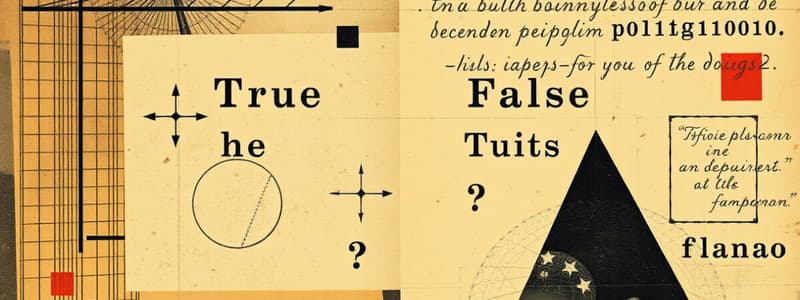Podcast
Questions and Answers
A system of one linear equation in two variables is always consistent.
A system of one linear equation in two variables is always consistent.
True (A)
A system of two linear equations in three variables is always consistent.
A system of two linear equations in three variables is always consistent.
False (B)
A linear system can have exactly two solutions.
A linear system can have exactly two solutions.
False (B)
Two systems of linear equations are equivalent when they have the same solution set.
Two systems of linear equations are equivalent when they have the same solution set.
A consistent system of linear equations can have infinitely many solutions.
A consistent system of linear equations can have infinitely many solutions.
A homogeneous system of linear equations must have at least one solution.
A homogeneous system of linear equations must have at least one solution.
A system of linear equations with fewer equations than variables always has at least one solution.
A system of linear equations with fewer equations than variables always has at least one solution.
If A is an m x n matrix and B is an n x r matrix, then the product AB is an m x r matrix.
If A is an m x n matrix and B is an n x r matrix, then the product AB is an m x r matrix.
For the product of two matrices to be defined, the number of columns of the first matrix must equal the number of rows of the second matrix.
For the product of two matrices to be defined, the number of columns of the first matrix must equal the number of rows of the second matrix.
The system Ax = b is consistent if and only if b can be expressed as a linear combination of the columns of A, where the coefficients of the linear combination are a solution of the system.
The system Ax = b is consistent if and only if b can be expressed as a linear combination of the columns of A, where the coefficients of the linear combination are a solution of the system.
If a linear system is consistent, then it has infinitely many solutions.
If a linear system is consistent, then it has infinitely many solutions.
A system of three linear equations in two variables is always inconsistent.
A system of three linear equations in two variables is always inconsistent.
A 6 x 3 matrix has six rows.
A 6 x 3 matrix has six rows.
Every matrix is row-equivalent to a matrix in row-echelon form.
Every matrix is row-equivalent to a matrix in row-echelon form.
If the row-echelon form of the augmented matrix of a system of linear equations contains the row [1 0 0 0 0], then the original system is inconsistent.
If the row-echelon form of the augmented matrix of a system of linear equations contains the row [1 0 0 0 0], then the original system is inconsistent.
Every matrix has a unique reduced row-echelon form.
Every matrix has a unique reduced row-echelon form.
A homogeneous system of four linear equations in six variables has infinitely many solutions.
A homogeneous system of four linear equations in six variables has infinitely many solutions.
A homogeneous system of four linear equations in four variables is always consistent.
A homogeneous system of four linear equations in four variables is always consistent.
There is only one way to parametrically represent the solution set of a linear equation.
There is only one way to parametrically represent the solution set of a linear equation.
A 4 x 7 matrix has four columns.
A 4 x 7 matrix has four columns.
Multiplying a row matrix by a constant is one of the elementary row operations.
Multiplying a row matrix by a constant is one of the elementary row operations.
The matrix equation Ax = b, where A is the coefficient matrix and x and b are column matrices, can be used to represent a system of linear equations.
The matrix equation Ax = b, where A is the coefficient matrix and x and b are column matrices, can be used to represent a system of linear equations.
What is the difference between row-echelon form and reduced row-echelon form?
What is the difference between row-echelon form and reduced row-echelon form?
What steps are involved in Gaussian elimination?
What steps are involved in Gaussian elimination?
What are homogeneous equations?
What are homogeneous equations?
When are two matrices considered equal?
When are two matrices considered equal?
Flashcards
Consistent Linear System
Consistent Linear System
A system of linear equations that has at least one solution.
Inconsistent Linear System
Inconsistent Linear System
A system of linear equations that has no solution.
System of Equations with Infinite Solutions
System of Equations with Infinite Solutions
A system where the equations represent the same or overlapping lines; therefore, an infinite number of solutions exist in the system.
Equivalent Systems
Equivalent Systems
Signup and view all the flashcards
Homogeneous System of Equations
Homogeneous System of Equations
Signup and view all the flashcards
Matrix Product Dimensions
Matrix Product Dimensions
Signup and view all the flashcards
Matrix dimensions
Matrix dimensions
Signup and view all the flashcards
Linear Combination of Columns
Linear Combination of Columns
Signup and view all the flashcards
Row-Echelon Form
Row-Echelon Form
Signup and view all the flashcards
Reduced Row-Echelon Form
Reduced Row-Echelon Form
Signup and view all the flashcards
Elementary Row Operation
Elementary Row Operation
Signup and view all the flashcards
Gaussian Elimination
Gaussian Elimination
Signup and view all the flashcards
Augmented Matrix
Augmented Matrix
Signup and view all the flashcards
Back-substitution
Back-substitution
Signup and view all the flashcards
Equality of Matrices
Equality of Matrices
Signup and view all the flashcards
Matrix Multiplication
Matrix Multiplication
Signup and view all the flashcards
Parametrizing Solutions
Parametrizing Solutions
Signup and view all the flashcards
Linear System with One Solution
Linear System with One Solution
Signup and view all the flashcards
Matrix Consistency
Matrix Consistency
Signup and view all the flashcards
Matrix Inconsistency
Matrix Inconsistency
Signup and view all the flashcards
Study Notes
Linear Systems and Consistency
- A system of one linear equation in two variables is always consistent.
- A system of two linear equations in three variables may not be consistent due to potential contradictory equations.
- Linear systems cannot have exactly two solutions; they can have either none, one, or infinitely many solutions.
- Two systems are equivalent if they share the same solution set, regardless of their individual representations.
- Consistent systems may have infinitely many solutions depending on the relationships between the equations.
- Homogeneous systems guarantee at least one solution (the trivial solution), specifically when they consist of linear equations set to zero.
Matrix Operations and Products
- The product of an m x n matrix A and an n x r matrix B results in an m x r matrix.
- Matrix multiplication is defined strictly when the number of columns in the first matrix matches the number of rows in the second.
- A system depicted as Ax = b is consistent if vector b can be formed as a linear combination of the columns of A by utilizing solutions to the system.
Matrix Forms and Characteristics
- A linear system's consistency doesn't always imply infinitely many solutions; it can also have exactly one solution.
- A six-row by three-column matrix is correctly defined with six rows.
- Every matrix can achieve a form known as row-echelon form, with particular properties including the arrangement of zero rows and leading 1's.
- Each matrix possesses a unique reduced row-echelon form, which is a refined version of the row-echelon form where leading 1's are the only non-zero entries in their respective columns.
Types of Linear Equations
- Homogeneous systems that involve more variables than equations typically yield infinitely many solutions, ensuring consistency.
- A homogeneous system with an equal number of equations and variables is guaranteed to be consistent.
- There are multiple ways to parametrize the solution set of a linear equation; uniqueness is not a characteristic of all parameterizations.
Miscellaneous Concepts
- A 4 x 7 matrix has seven columns, not four, highlighting the importance of matrix dimension notation.
- Multiplying a row matrix by a constant is not recognized as an elementary row operation when the constant is not specified to be non-zero.
- The equation Ax = b, involving coefficient matrix A along with column matrices x and b, provides a formal representation of a system of linear equations.
Gaussian Elimination Process
- The Gaussian elimination method involves writing the augmented matrix, transforming it to row-echelon form, and then applying back-substitution to derive the solution.
Equality of Matrices
- Two matrices are considered equal when they match in dimensions and all corresponding entries are identical across both matrices.
Studying That Suits You
Use AI to generate personalized quizzes and flashcards to suit your learning preferences.




